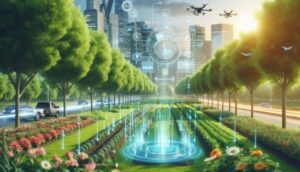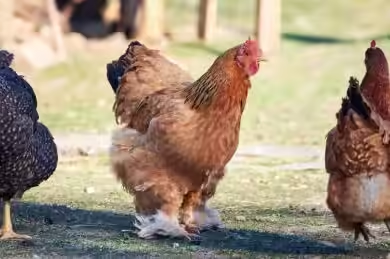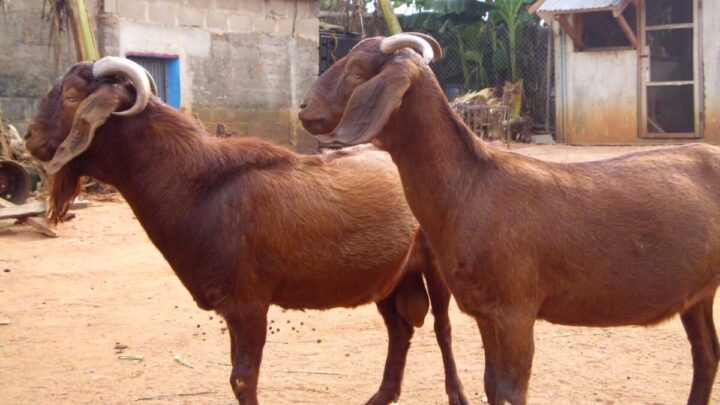Last updated on July 28, 2025
You’ve heard the promise: smart irrigation can slash water bills, send yields soaring, and even help your crops laugh in the face of climate shifts. In our Ultimate Guide to Agritech in Nigeria, we painted that big picture. But what’s truly making it happen at the root level? It’s not magic; it’s the quiet power of sensors – tiny guardians buried in your soil, perched on weather stations, and woven into your pipes.
This isn’t just another list of gadgets. This guide is your technical deep dive, your hands-on manual to the unsung heroes of modern irrigation. We’re going beyond the buzzwords to compare core technologies, demystify the specs, and arm you with the practical knowledge to choose precisely the right hardware for your farm’s unique needs, climate, and crops. Get ready to transform how you think about watering.
Smart Irrigation Sensor Comparison: Which Do You Need?
To help you quickly navigate the options, here’s an overview of the core sensor types discussed in this guide and what they do best for your farm:
| Sensor Type | What It Measures | Best For… | Key Consideration |
|---|---|---|---|
| 💧 Soil Moisture (Capacitance) | % of water in soil (VWC) | Automated, percentage-based irrigation triggers; sandy/loamy soils | Requires soil-specific calibration for best accuracy. |
| 💧 Soil Moisture (Tensiometric) | How hard plants work for water | Understanding plant stress; heavy clay soils; manual monitoring | Requires periodic refilling with water. |
| ☁️ Weather Sensors | Rainfall, wind speed, light/solar radiation | Preventing waste from environmental factors; calculating water budgets | Must be placed in an open, unobstructed area. |
| 🚨 Flow Sensors | Liters per minute (LPM) of water flow | Instant leak detection; monitoring system infrastructure health | Must be installed correctly on the main pipeline. |
| 🧪 pH & Salinity Sensors | Water pH (acidity/alkalinity), Electrical Conductivity (EC) | High-tech greenhouses; farms practicing fertigation; water quality control | Critical for nutrient uptake and preventing toxicity. |
💧 Speaking the Soil’s Language: The Core of Smart Watering
At the heart of any truly smart irrigation system are soil moisture sensors. These ingenious devices act as your eyes below ground, providing real-time data about the most critical factor: how much water is actually available to your plants in their root zone. This ‘ground truth’ is what finally liberates you from wasteful, arbitrary watering schedules.
Within this vital category, two main contenders emerge, each speaking a slightly different dialect of the soil’s language: Capacitance Sensors and Tensiometric Sensors. Understanding their nuances is key to choosing your farm’s subterranean allies.
Soil Moisture Sensors: Capacitance vs. Tensiometric at a Glance
| Feature | Capacitance Sensors | Tensiometric Sensors |
|---|---|---|
| How it Works | Measures changes in soil’s dielectric constant | Measures soil water tension (suction force) |
| What it Measures | Volumetric Water Content (VWC) as a percentage (%) | Soil Water Potential in kilopascals (kPa) |
| Best For | Fast, automated irrigation decisions; sandy/loamy soils | Understanding plant effort; heavy clay soils |
| Pros | Provides instant readings; easy automation integration | Direct measure of water availability to the plant |
| Cons | Requires soil-specific calibration; sensitive to salinity | Slower response time; requires periodic maintenance |
| Price Range | Moderate | Low to Moderate |
Capacitance Sensors: Instant Insights into Soil Hydration
Imagine a sensor that can tell you, almost instantly, the precise percentage of water in your soil. That’s the power of a capacitance sensor.
- How They Work: These sensors measure changes in the soil’s dielectric constant. Simply put, water has a much higher dielectric constant than soil particles. As water content in the soil changes, so does its electrical permittivity, which the sensor detects and translates into Volumetric Water Content (VWC) – a direct percentage of water by volume.
- Their Strength: They offer fast, immediate readings and are typically very easy to integrate with automated irrigation systems. If your primary goal is to trigger your system when soil moisture drops below a specific, pre-set percentage (e.g., “start watering when moisture hits 30%”), capacitance sensors are your champions. They perform exceptionally well in sandy and loamy soils where water movement is relatively free.
- Considerations: To be truly accurate, they often require soil-specific calibration when first installed, as different soil types (clay, sand) can affect their readings. High salinity in the soil can also sometimes influence their precision.
Tensiometric Sensors: Feeling Your Plant’s Thirst
While capacitance sensors tell you “how much water,” tensiometric sensors tell you “how hard the plant is working to get that water.” They measure the suction force the plant needs to extract moisture.
- How They Work: These sensors consist of a porous ceramic tip connected to a water-filled tube. As the soil dries, it pulls water from the sensor through the ceramic tip, creating a vacuum (tension) inside the tube. This tension is directly measured in kilopascals (kPa), representing the Soil Water Potential.
- Their Strength: Tensiometric sensors provide a direct measure of water availability to the plant, irrespective of soil type. This is particularly valuable in heavy clay soils where VWC readings can sometimes be misleading. They truly help you understand your plant’s effort and stress levels.
- Considerations: They generally have a slower response time than capacitance sensors. More significantly, they require periodic maintenance, specifically refilling the tube with water, to ensure they remain accurate.
The Bottom Line: If your priority is fast, automated, percentage-based watering, lean towards capacitance sensors. If you want a deeper understanding of your plant’s actual effort and stress, especially in trickier soil types, tensiometric sensors offer unparalleled insight, though with a bit more upkeep.
☁️ Listening to the Atmosphere: Weather-Based Sensors for Smart Decisions
Irrigation decisions aren’t made in a vacuum. Your crops don’t just respond to what’s below ground; they react constantly to the sky above. Weather sensors provide the vital environmental context needed to fine-tune watering schedules, avoid waste, and proactively protect your crops.
- Rain Sensors:
- Their Purpose: These simple, yet incredibly effective, devices automatically pause a scheduled irrigation cycle the moment they detect rainfall.
- Nigerian Relevance: For any farm, especially in Southern Nigeria’s often unpredictable rainy season, a rain sensor is a low-cost, essential safeguard. It prevents the truly wasteful (and sometimes embarrassing) act of watering your crops during a downpour.
- Wind Sensors:
- Their Purpose: They constantly monitor wind speed and will temporarily disable your irrigation system if winds become too high.
- Practical Impact: Crucial for farms employing sprinkler or pivot irrigation systems. High winds can cause massive water drift, leading to precious water evaporating or being blown away before it ever reaches the crop root zone. A wind sensor ensures your water goes where it’s needed, every time.
- Light/Solar Radiation Sensors:
- Their Purpose: These sensors track the intensity of sunlight your crops are receiving. Light intensity is a primary driver of evapotranspiration – the process by which plants “breathe” water out through their leaves and water evaporates from the soil surface.
- Practical Application: Most useful in controlled environments like greenhouses or for high-value specialty crops. By accurately tracking solar radiation, you can calculate a precise daily water budget for your plants, ensuring they get exactly what they need, not a drop more or less.
🚨 Water Flow Sensors: Your System’s Sentinel for Leak Detection
While soil and weather sensors tell you about the environment, a water flow sensor acts as the diligent watchdog for your irrigation system itself. It’s less about the plants’ needs and more about the health and efficiency of your infrastructure.
- How They Work: Installed strategically on the main pipeline (often after the primary valve but before individual zone valves), these sensors continuously measure the volume of water flowing through the system in Liters Per Minute (LPM).
- Their Primary Function: Leak Detection. This is where their value truly shines. You can program your smart controller to recognize the “normal” flow rate for each irrigation zone. For instance, if Zone 1 typically uses 100 LPM, but the flow sensor suddenly reports 150 LPM, it’s a red flag. The system knows instantly that there’s a problem – perhaps a burst pipe, a broken sprinkler head, or a significant leak. It can then automatically shut off that zone and send you an immediate alert (via SMS or app notification), preventing catastrophic water loss, extensive field flooding, and costly damage. It’s an insurance policy against unexpected failures.
🧪 pH and Salinity Sensors: Your Water Quality Experts
For farms pushing the boundaries of precision, particularly those using fertigation (applying fertilizers through the irrigation water) or growing highly sensitive crops, pH and Salinity sensors become indispensable. These are your water quality experts.
- What They Do: These sensors measure two critical parameters of your water:
- pH (acidity/alkalinity): The pH level of your irrigation water directly impacts nutrient availability. If the pH is too high or too low, even if nutrients are present in the soil or water, your plants may not be able to absorb them effectively.
- Electrical Conductivity (EC): EC indicates the level of dissolved salts in the water. High salinity can stress plants, hinder water uptake, and even become toxic, especially in regions with naturally saline water or where certain fertilizers are heavily used.
- Practical Impact: These sensors are vital in high-tech greenhouse operations or on farms where precise nutrient management is key. They ensure your fertigation solution is perfectly balanced for optimal nutrient uptake and that salt levels don’t build up to damaging concentrations, safeguarding your crop health and maximizing fertilizer efficiency.
Adopting smart irrigation in Nigeria comes with its unique set of challenges, but for every hurdle, there’s a practical, often locally adaptable, solution.
- The Power Conundrum: Nigeria’s inconsistent national grid can be a major headache for any electronic system. The smart solution? Embrace solar-powered sensors and controllers. These self-sufficient units, often with built-in battery storage, dramatically reduce your dependency on erratic grid power, offering a truly reliable option for remote farm sections.
- Bridging the Cost Gap for Smallholders: The upfront cost of advanced systems can feel daunting. The answer isn’t to wait, but to start small and smart. Invest in a single, affordable soil moisture sensor for a high-value plot (like your vegetable nursery or a cash crop section). Prove the concept, track your water savings and yield gains, and use that demonstrable ROI to justify scaling up. Community cooperatives could also explore shared sensor systems.
- The Human Element: Calibration & Maintenance: Sensors aren’t set-and-forget devices. They require periodic calibration (typically every 6-12 months) and proper placement in the active root zone of your crop for accurate readings. Investing in basic training for farm staff on sensor care ensures their longevity and reliability, turning technology into a sustained advantage.
Tailoring Technology: Choosing the Right Sensors for Your Nigerian Farm
Forget a one-size-fits-all approach. The “best” sensor setup is always the one that precisely matches your farm’s scale, crops, and challenges.
- For the Vigilant Smallholder (e.g., Vegetable Plot in the Middle Belt): Start simple, yet effective. An affordable, standalone soil moisture sensor (like the ECOWITT WH51 mentioned previously) provides immediate, actionable insight. It tells you exactly when to water your precious vegetables, preventing both underwatering and costly overwatering without a complex system.
- For the Ambitious Commercial Grower (e.g., Large Rice or Maize Farm in the North): Scale up your insight. A robust, multi-level soil probe (such as the Sentek Drill & Drop) becomes a powerful investment. These probes offer moisture readings at different depths within the soil profile, providing a far more complete picture essential for managing large-scale irrigation systems like center pivots. Add a rain sensor to avoid watering after a downpour.
- For the High-Tech Cultivator (e.g., Modern Greenhouse Operation near Lagos or Abuja): Here, precision demands a full suite of interconnected sensors. Invest in high-accuracy soil moisture sensors at multiple depths, a comprehensive weather station (measuring light, humidity, temperature for VPD calculations), and crucially, pH/EC sensors to meticulously manage your fertigation solution for optimal nutrient delivery.
Your First Steps: A Practical Checklist to Smart Irrigation
Ready to transform your watering practices? Here’s a clear, actionable roadmap to integrating smart sensors into your farm:
- Check Your Controller’s Compatibility (CRITICAL!): Before buying any sensor, thoroughly inspect your current irrigation controller. Does it have dedicated “SEN” (sensor) input ports? Is it advertised as a “smart” controller designed to integrate with sensor data? Trying to connect an advanced sensor to a basic timer is a recipe for frustration. Ensure the controller you have—or plan to buy—is fully compatible with your desired sensors.
- Define Your Primary Pain Point: Conduct a quick audit of your farm. What’s your biggest watering challenge? Is it obvious water waste, struggling crops, or constantly bursting pipes? Identify the #1 problem you need to solve, then select the sensor that directly addresses it.
- Install Sensors with Precision: Don’t just stick them anywhere. Follow the manufacturer’s guidelines meticulously. Place soil sensors accurately in the active root zone of your crops, position weather sensors in an open area away from obstructions, and install flow sensors correctly on your main pipeline (typically after the main valve).
- Connect to Your Smart Controller: Carefully wire the sensor to the designated input port on your smart controller. Most modern systems are designed for straightforward connections.
- Integrate with Mobile Access: Download your controller’s dedicated mobile application (e.g., Hydrawise, RainMachine, FieldView if integrated). This app is your remote command center, allowing you to monitor data, receive alerts, and adjust settings from anywhere.
- Test, Calibrate, and Optimize: Run initial tests to ensure data is flowing correctly. Calibrate your sensors as recommended. Then, crucially, observe your system for a few weeks. Monitor the data, watch your crop’s response, and make small adjustments to your irrigation schedules until you achieve maximum efficiency and optimal plant health. This iterative process is key to unlocking the full power of smart irrigation.
Conclusion: The Era of Water Wisdom on Your Farm
The “smart” in smart irrigation isn’t a marketing gimmick; it comes directly from the precise, real-time data provided by its diverse array of sensors. By choosing to move beyond guesswork and embracing decisions informed by the actual conditions of your soil, the surrounding weather, and the performance of your system, you can achieve profound results. You will not only significantly reduce your input costs and conserve a precious resource, but also dramatically improve the health, resilience, and productivity of your crops. The key to unlocking this potential is simple: start with a clear understanding of your needs, select the right hardware for the job, and commit to listening to what your farm is telling you, through its sensors.
To truly appreciate how these sensors fit into the broader landscape of agricultural technology, including software and automation, we encourage you to explore our Ultimate Guide to Agritech in Nigeria. And for a deeper dive into the tools that help manage all this data, check out our review of the 10 Best Farm Management Software & Tools for Nigerian Farmers. Your journey to water wisdom starts now.
Frequently Asked Questions (FAQs)
Why are soil moisture sensors considered the most essential for smart irrigation?
Soil moisture sensors provide direct, real-time data on the actual water content in your crop’s root zone, allowing you to irrigate precisely when needed, preventing both underwatering and costly overwatering.
What’s the main difference between capacitance and tensiometric sensors?
Capacitance sensors measure the volumetric water content (VWC) as a percentage, ideal for automated triggering. Tensiometric sensors measure soil water tension (how hard plants work for water), offering deeper insight, especially in clay soils.
How can weather sensors prevent water waste?
Rain sensors automatically pause irrigation during rainfall, while wind sensors disable systems during high winds to prevent water drift and evaporation, ensuring water reaches the target.
Can smart irrigation sensors help detect leaks in my system?
Yes, water flow sensors are specifically designed for this. By monitoring the volume of water flowing through pipes, they can detect abnormal surges that indicate a burst pipe or leak, triggering an alert to prevent extensive water loss.
Are pH and salinity sensors necessary for all farms?
They are most critical for high-tech greenhouse operations or farms practicing fertigation, where precise control over water quality and nutrient balance is essential to prevent toxicity and ensure optimal plant uptake.
Do I need a strong internet connection for smart irrigation sensors to work?
Many sensors gather data locally, and some smart controllers can operate offline. However, an internet connection is usually needed for remote monitoring via a mobile app, receiving alerts, and syncing data with cloud-based platforms.
What’s the first step a Nigerian farmer should take to implement smart irrigation sensors?
The most critical first step is to check if your existing irrigation controller (or the one you plan to buy) has the necessary sensor input ports and smart capabilities for integration. Compatibility is key.
Glossary of Key Terms
- IoT (Internet of Things): A network of interconnected devices that communicate and share data over the internet.
- Capacitance Sensor: A sensor that measures soil moisture based on changes in the dielectric constant.
- Tensiometric Sensor: A device that measures soil water potential in kilopascals (kPa).
- VWC (Volumetric Water Content): The volume of water in a given volume of soil, usually expressed as a percentage.
- VPD (Vapor Pressure Deficit): A measurement of the difference between the amount of moisture in the air and its maximum capacity, indicating plant transpiration stress.
- EC (Electrical Conductivity): A measure of soil or water salinity that affects plant nutrient uptake.
- LPM (Liters Per Minute): A metric unit of water flow measurement.


